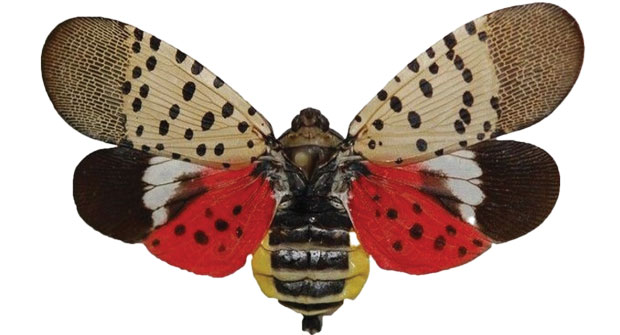
The invasive spotted lanternfly remains a significant problem for North American ecosystems, including residential and commercial landscapes. Despite this destructive pest’s numerous challenges, landscape contractors are crucial in slowing its spread and mitigating the economic impact on clients’ properties.
The spotted lanternfly (Lycorma delicatula) has populated 18 states, with infestations concentrated in the Northeast and Mid-Atlantic regions, says Ken Johnson, extension educator in horticulture at the University of Illinois Extension, Jacksonville, Ill. However, researchers have confirmed its presence as far west as Chicago and the Nashville area, setting the stage for the lanternfly’s expansion westward.
First detected in the U.S. in 2014, concern initially focused on the potential damage the lanternfly could inflict on trees. Researchers now view it as a significant plant stressor, including ornamental trees and shrubs, on residential and commercial properties.
“With healthy trees, we’re not seeing the damage as bad as it was originally feared,” Johnson says. “Its preferred host is tree of heaven (Ailanthus altissima), which isn’t necessarily a bad thing because it’s considered an invasive species in a lot of places. However, it has been known to feed on grape vines, black walnut seedlings, fruit trees, ornamentals and the tender new growth of vegetable crops.”
Richard Fletcher, technical services manager, turf and ornamentals at Nufarm, anticipates its eventual distribution to mirror the lanternfly’s food sources.
“We know about its relationship with tree of heaven as far as a late-season sugar source,” he says. “It’s got a few other favorite trees that it likes to eat off, and one is maples. So, we’re anticipating it going wherever maples grow.”
Mitigation strategy
Spotted lanternfly adults lay eggs in the fall on tree trunks, branches and other smooth surfaces — like the sides of landscape trailers. Johnson says the eggs are off-white, grayish in coloring, which blends well against the typical covered landscape equipment trailer. Therefore, contractors are encouraged to carefully inspect equipment and vehicles before moving them from one client’s property to the next.
Eggs hatch in the spring or as soon as the weather begins to warm, and hungry nymphs — which can travel three to four miles in an evening — go through various phases before becoming adults in late summer. Fletcher says the nymphs are susceptible to multiple mitigation methods.
The first is a contact-type treatment with a pyrethroid base or a systemic-type material, such as a neonicotinoid, in late May and early June, Fletcher says. “These are very, very effective,” he says.
“And the nice thing about the systemic materials is they move rapidly in the transpiration-driven water. So, when the tree pops out leaves and the sun shines, it pulls water from the roots out to the leaves, carrying the chemical to the edge of the canopy and where these guys are eating. Once (the lanternfly) hatches, you can nuke them with a contact and then come back with a systemic to get that extended period of management,” Fletcher adds.
While sticky bands applied around tree trunks in late June and July serve as an effective physical barrier to capture nymphs traversing between trees, Fletcher cautions they can quickly clog up. He advocates for a comprehensive program that disrupts the pest’s lifecycle at multiple stages.
“This includes systemic (treatment) after egg hatch, a physical barrier mid-summer and then when these guys are adults in late August and early September, you can either use a systemic or a contact,” he says. “This isn’t a one-and-done approach. You have to do more than one thing to break the lifecycle.”
There is some good news — researchers are observing new allies in the fight against the spotted lanternfly.
“Bird species have figured out they can eat them,” Fletcher says. “And in the Northeast, the last two or three years have experienced cooler, wetter springs, which means natural populations of bacteria or fungi, in particular Beauveria native to forests, have been enough to give us some management of the eggs and even the very young juveniles.”


